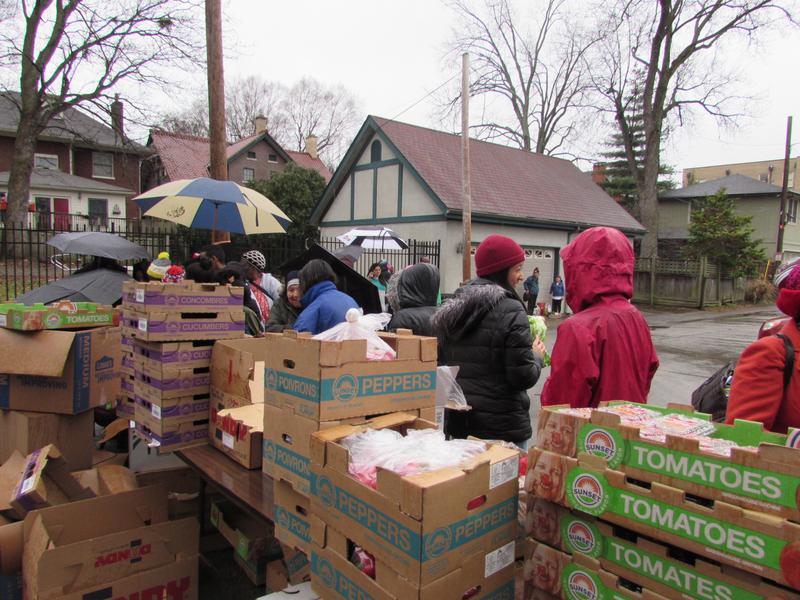by Rhonda Miller. This article originally appeared on WKU Public Radio. This is part one of a three part series; you can read part one here and read part two here.

Volunteers at the Kentucky Refugee Ministries and Dare To Care food bank offer fresh vegetables on a rainy afternoon. (Photo by Rhonda Miller)
Feeding Kentucky, a nonprofit with a mission to alleviate hunger across the Bluegrass State, reports that food insecurity is a reality for one in 10 residents age 60 and older.
Elder refugees
The opinions expressed in this article are those of the author and do not necessarily reflect those of the Diverse Elders Coalition.
in Kentucky face an ever higher risk of hunger due to language barriers and lack of transportation.
On a recent rainy afternoon in Louisville, refugees–some of them in their 60s, 70s, 80s and 90s–lined up at outdoor tables filled with fresh leafy green lettuce, bright red bell peppers, cucumbers and mushrooms.
John Gowling, a volunteer for Kentucky Refugee Ministries, began enthusiastically offering mushrooms and other food items to the refugees.
“Sometimes they can’t even speak English so they gesture and smile, but you know, it’s usually just hello and thank you,” Gowling said.
Kentucky Refugee Ministries, or KRM, is a resettlement agency that has the state’s only federally-funded program for refugees 60 and older. This once-a-month mobile food pantry is a partnership between KRM and Louisville’s Dare to Care food bank.
Eva Nyerges is the KRM coordinator for the Louisville Refugee Elder Program.
“We have on occasion had people say, ‘You know, I don’t have enough money for food. I don’t have food stamps. Will you take me to a food pantry?’” said Nyerges. “And that’s why we kind of started trying to show individual people their local food pantry and help them get down here to KRM’s mobile food pantry.”
Nyerges says most of those in the Refugee Elder Program get Supplemental Security Income, or SSI.
A spokesman for the U.S. Department of Agriculture Food and Nutrition Service said refugees are eligible for benefits from the Supplemental Nutrition Assistance Program, or SNAP, based on income and resources. He said the minimum SNAP benefit for a one or two-person household is $16 a month.
Nyerges says some of these elder refugees get that $16 a month minimum.
“I think it can be hard for some people who are living on their own, and they get SSI,” said Nyerges. “Unless they’re in low-income senior housing, most of that SSI is going to go towards their rent.”
At the outdoor food pantry, one of the elder refugees trying to manage two bags of vegetables and an umbrella is 75-year-old Namagishu Namahoro. She’s from the Democratic Republic of Congo and spoke through interpreter Patrick Bagaza.
“Yes, I’m happy just to get the food,” said Namahoro. When asked what kind of items she was looking for, Bagaza said “tomatoes and other names she doesn’t know, but the food she got she’s happy, it’s good.”
There’s no specific data on how many elder refugees are food insecure. But director of the University of Kentucky’s Center for Poverty Research, James Ziliak, said we can look at related data. He’s co-author of the annual report, The State of Senior Hunger in America.
“We do know that, in general, immigrants overall face higher risk of food insecurity than persons born in the United States,” said Ziliak. “We certainly would expect that refugees probably have heightened food insecurity in part because oftentimes refugees are fleeing precarious economic situations in their home country.”
Even though elder refugees face many challenges in having steady supply of fresh, nutritious food, they are far from alone. Across the nation, nearly five million people age 60 and over are at-risk for hunger.
This story was produced with the support of a journalism fellowship from the Gerontological Society of America, Journalists Network on Generations and Silver Century Foundation.
The opinions expressed in this article are those of the author and do not necessarily reflect those of the Diverse Elders Coalition.
